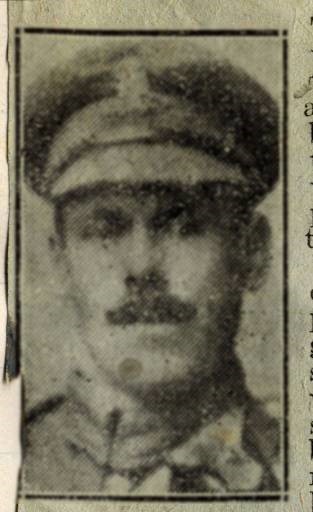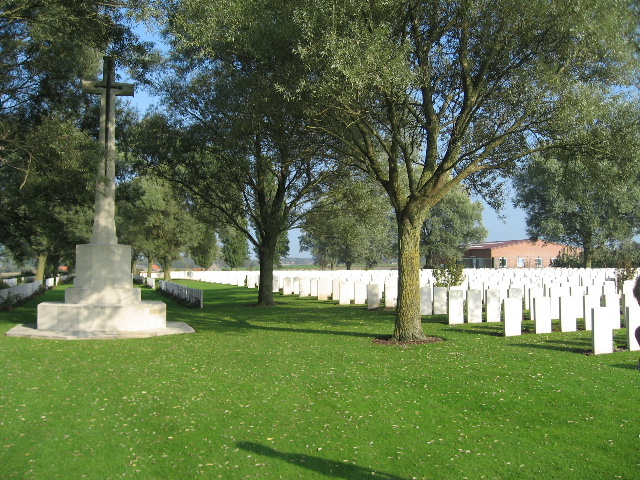Name
Albert John Titmuss
Conflict
First World War
Date of Death / Age
23/10/1917
32
Rank, Service Number & Service Details
Corporal
L/37084
Royal Field Artillery
169th Brigade
'B' Battery
Awards: Service Medals/Honour Awards
British War and Victory medals
Cemetery/Memorial: Name/Reference/Country
PERTH CEMETERY (CHINA WALL)
VI. J. 7.
Belgium
Headstone Inscription
Death Divides Sweet Memories Cling
UK & Other Memorials
Pirton Village War Memorial,
St Mary’s Shrine, Pirton,
Methodist Chapel Plaque, Pirton,
Pirton School Memorial
Biography
The Commonwealth War Graves Commission lists Albert as serving in “B” Battery, 169th Brigade, Royal Field Artillery; however his service record is quite clear and his final listing, at his death, records the 189th Brigade Ammunition Column.
Albert was the fifth child and first son of George and Emma Juliana Titmuss (née Cherry). Both parents and all their eight children(*1) were Pirton born and bred. Between 1891 and 1911 the family lived in Burge End, Bury End and then Church Baulk.
After attending Pirton School, Albert followed his father to work on the farms around Pirton, while his mother earned extra money as a strawplaiter. Sadly she died in 1909 aged fifty-three.
By 1911, Albert was recorded as working as a general labourer, but by 1915 we know from his war service records that he was 30, living at 39 Charteris Road, Finsbury Park, London and working as a railway carman – a driver of a horse-drawn vehicle, usually making local deliveries and collections.
He heeded the call to arms and enlisted, signing his attestation papers in Hampstead on August 16th 1915, becoming Driver 37084, 183rd Howitzer Brigade, Royal Field Artillery (RFA). He went for his training and it was during this period that he returned to Pirton for his wedding to Elsie Goldsmith on March 20th 1916. He was probably aware that he would soon be posted to the war, and when he was his new wife remained in Pirton living around Little Green.
By May he was fully trained and on the 2nd he embarked from Southampton arriving in Le Havre the next day. He was posted to the 41st Divisional Ammunition Column (DAC) on the 23rd and appointed as acting Bombardier on June 9th.
The ammunition columns were manned by the members of the Royal Field Artillery (RFA) and could be called upon to supply any unit requiring ammunition. In addition the men employed in the Ammunition Column could be required to replace casualties in the artillery batteries. The work supplying the guns would have meant travelling supply routes which, if identified, would then have been targeted by the enemy’s guns. Delivering the ammunition to the guns meant going to locations also targeted and potentially close to the front line – all dangerous situations.
We do not know how close to danger Albert came during the next few months, but it was probably very close and it would have been with great relief that he received news of his allocation of leave to England and he set off for two weeks’ leave, starting on November 27th. Shortly after his return, his section of the ammunition column became the 189th Brigade Ammunition Column and at the end of January, confusingly, he seems to have been appointed acting Bombardier for the second time. A Bombardier was qualified to lay a gun for use or perhaps even a whole Battery, which might number three or four guns. However, while working in the ammunition column he may not have used that skill, at least not regularly.
Albert continued doing his duty, probably experiencing much more of the same hard work and danger. His appointment to Bombardier was confirmed on March 31st. After another six months, he got the news of more leave to the UK, relatively short though, September 27th to October 7th 1917, but a newspaper report confirms that he managed to get back to Pirton. Upon his return he received the good news that he had been promoted to acting Corporal.
The events leading up to Albert’s death are not clearly documented. There are no entries in his service records to suggest that he was permanently posted away from the 189th Brigade Ammunition Column to a ‘firing’ battery of the RFA. However, the local newspaper reporting his death referenced a letter written by Serjeant Gay and it seems conclusive and that he was serving with the guns when he died. Perhaps this explains the fact that the Commonwealth War Graves Commission and the Soldiers Died in The Great War database record Albert as in “B” Battery, 169th Brigade, Royal Field Artillery, which conflicts directly with his service records. They have 189th Brigade written clearly against ‘Killed in Action’ and also in their letter, dated March 19th 1918, requesting that his personal possessions be dispatched to his wife.
The clue that explains this confusion may be his recent leave. When he returned from leave in October, a short time before his death, he may not have been able to return to his normal duties, his situation may have been confused and transportation may have been scarce so he may have temporarily been assigned to the guns. It is also possible that after supplying the guns he was ordered to assist them. As mentioned above, soldiers serving in ammunition columns were required to assist the guns when necessary due to casualties etc. So it can be surmised that he was ‘helping out’ at the guns and that they were the 169th. We shall probably never be certain, but we do know that Serjeant Gay wrote that ‘he had not been long with us in the battery’ and that the ‘posting’ was not properly recorded and therefore may not have been official, but it is certain that he was with them for only a brief period before his death.
Working on the assumption that one of the situations described above is correct, then it is appropriate to give a little information on the 169th and their whereabouts in October 1917.
In 1916 the 169th Brigade consisted of four batteries, “A” to “D” and twelve 18 pounder guns and eight 4.5 inch howitzers and in 1917 that was probably still the case. Although they had been in France, by October 1917 they were in Belgium, and were involved as artillery support in the Battle of Passchendaele, or Third Battle of Ypres. Artillery support typically included shelling the enemy lines and key targets, support for the infantry when enemy movements were spotted and increasing in intensity during the preparation for attacks. The RFA Batteries were often at risk of retaliation from their enemy counterparts.
Albert’s death was first reported in the Hertfordshire Express dated November 11th under the headline ‘True and Honest Comrade – Pirton Man Who Fell by His Guns’ and then again on December 1st 1917. Both reports had the date as ‘on or about October 31’. Although the date may have been wrong they were quoting from the letter written by Serjeant Gay, who was in the same Battery, to Albert’s wife, ‘They were getting the guns in action when a shell exploded near the battery.’ Albert was hit and badly injured. They took him to a place of safety, but ‘he expired before he reached the dressing station.’ It seems likely that he was killed in one of the commonplace artillery ‘duels’ of the war.
His date of death is officially recorded as October 23rd 1917. At that time the Third Battle of Ypres was nearing its end, but still being fought in appalling conditions – the soldiers called it the Battle of Mud. The losses on both sides were huge, the British had lost 310,000 men and the Germans 260,000. The vast majority would have been from the front lines, but as Albert’s story proves, the artillery also suffered. The shock for his wife must have been compounded by the fact that his death was so soon after he had been home to Pirton on leave.
His body was buried in the Perth Cemetery (China Wall), located two miles east of Ypres’ town centre. The cemetery is another one holding men brought together from a surprising large number of smaller cemeteries, but was used in its own right for front line burials until October 1917. It now contains 2,791 burials or commemorations to Commonwealth servicemen, 1,422 are identified.
Visitors are met by the Cross of Sacrifice which immediately demands one’s attention. Then the avenue of trees drags one’s eyes to the distance, but as they descend the realism of the headstones, heading towards the horizon, begins to focus your thoughts on what they represent. Albert’s headstone bears the inscription chosen by his family which reads ‘Death Divides Sweet Memories Cling’.
(*1) Mary (bapt 1876), Elizabeth (bapt 1878), Peggy (b 1879), Ellen Rose (b 1882), Albert John (bapt 1884), Sidney (b 1888), Lilian (b 1892)(*2), Louisa (b 1893)(*2) and Frederick (b 1895).
(*2) There is a possibility that these Lilian and Louisa are the same person and the confusion arises from indistinct census records.
Additional Information
Text from the book: The Pride of Pirton
Acknowledgments
The Pride of Pirton book – www.pirton.org.uk/prideofpirton Chris Ryan / Tony French / Jonty Wild



